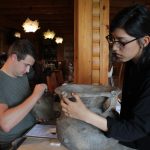Blog posted by Teresa Godinez
Communication Beyond Words
 As I walked down the aisle of the airplane and found my designated seat, a rush of excitement came over me as I realized that I was officially on my way to Hungary! If someone had told me that I would one day end up in Hungary, following my dreams and partaking in field school, I might not have believed them, much less even imagined it would be possible. However, there I was, a first-generation college student getting the opportunity to participate in the 2018 BAKOTA field school. Now that I reflect on myself before the trip, I realize that my knowledge has expanded from books to field, allowing me to become more open to experiences outside my comfort zone. Although it might be hard to condense my six week experience in a few words, I will try my best to provide a sneak peek of my journey.
As I walked down the aisle of the airplane and found my designated seat, a rush of excitement came over me as I realized that I was officially on my way to Hungary! If someone had told me that I would one day end up in Hungary, following my dreams and partaking in field school, I might not have believed them, much less even imagined it would be possible. However, there I was, a first-generation college student getting the opportunity to participate in the 2018 BAKOTA field school. Now that I reflect on myself before the trip, I realize that my knowledge has expanded from books to field, allowing me to become more open to experiences outside my comfort zone. Although it might be hard to condense my six week experience in a few words, I will try my best to provide a sneak peek of my journey.
Upon arrival in Budapest, I had the opportunity to meet the participants of the 2018 BAKOTA field school. After brief introductions, the crew settled in Szeged for the first week of the project. After recovering from jet lag and successfully buying water with a mix of helpful gestures in English and Hungarian (“bubbles nem”), I was prepared for the upcoming lectures. They included background information regarding the site (Békés103), an introduction to Hungarian Archaeology, and an opportunity to become familiar with the work of local archaeologists. Before I knew it, week two had arrived and the team was once again on the move, heading towards Vésztő. For the remainder of the five weeks, Vésztő would become the crew’s home. From this point on we all hit the ground running as data collecting began, lectures took place, and independent research questions began to be constructed. For my project, I had the privilege of being an official member of the ceramic team!
The ceramic team was made of three students including myself. Our initial task was to measure and code design elements from the collection of vessels that had been excavated previously. Although I didn’t know what the outcome of our data would be, I began to learn about the importance of style in ceramics. Both my mentors and the assigned readings showed me a new perspective surrounding style in material culture. Style is a complex topic that has the potential to demonstrate connections, boundaries, and even individualistic characteristics. As my curiosity continued to grow on the theoretical side of style in ceramics I was reminded of the importance of data collection. Standardization of our methods was key to this project because it synchronized measurements (with only 1mm range difference) for all the ceramics even with many people working on the same project. This meant that communication and patience were key and thankfully the ceramic team prevailed! Once all of the data was collected, the most challenging yet exciting part of the project began. We begun to explore the theoretical side of things in the hope of unveiling some interesting information regarding how the Bronze Age ceramics style reflected on the exchange of communication between regions.
The memories I have made in Hungary are unforgettable and have inspired me to continue to work hard and to let my curiosity run wild. I am thankful to both the American and Hungarian students and volunteers who taught me valuable skills and lessons that have certainly made an impact in my life. Even though I already knew being accepted to the BAKOTA field school was undoubtedly going to be an amazing opportunity, I could not have imagined how much of blessing it has been. However, there is still much more work ahead and so much more to learn, which makes me excited as to what the future has in store.
For more on the BAKOTA project’s research on Ceramics and other topics: http://bakota.net/publications/
For more general information regarding BAKOTA: http://bakota.net/
